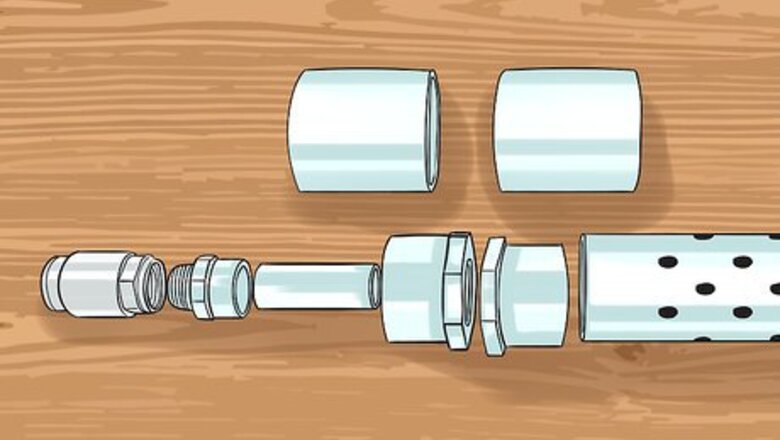
views
Building the water hand pump
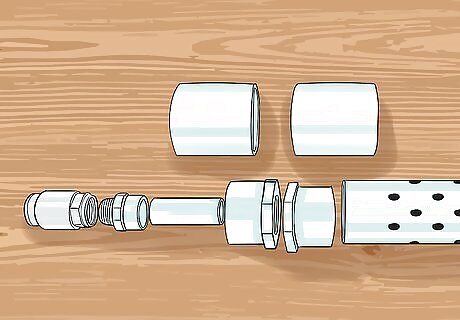
Build the foot valve assembly. The purpose of the foot valve is to allow water into the cylinder without allowing it to fall back out. (The cylinder is the lower pipe section containing the foot valve and plunder assemblies.) It is composed of, from bottom to top: a. 2in cap (not shown) b. 2in pipe screen with drilled holes (about 9in long) c. 2in coupler d. 2x3/4 reducer e. 2x3/4 reducer with the lip filed out to allow the 3/4in pipe to slide all the way through. f. 2in coupler (not shown in assembled image) g. 3/4in pipe (about 4 in long) h. 3/4in slip-male thread adapter i. 3/4in brass check valve j. 2in pipe about 36in long (not shown). It fits into coupler (f).

Build the plunger assembly. The plunger serves two purposes. First, it provides a seal with the cylinder to generate suction. Second, it contains a second check valve to allow water in the upper cylinder. a. 3/4in threaded pipe extender. Screws into bottom of check valve (d). b. Spacers. The purpose of the spacers is to keep the gasket rigid. They should not contact the cylinder. You can use a 2in hole saw to score a ring in each side, then use a 1-1/8in Forstner bit to bore out the inner hole. The hole saw can be again used to finish the outer cut. These can be made from wood or plastic. c. Leather gasket. Can also be made from rubber. Carefully cut this to fit snugly in the cylinder and on the pipe extender. When inserting the assembly in the cylinder to test the fit, first soften the leather with water. Otherwise, you will trim it too small and need to start over. d. 3/4in brass check valvee. 3/4in slip-male thread adapter f. 3/4in pipe 6in long with drilled holes. This allows water to enter the upper cylinder after passing through the check valve. g. 3/4x1/2in slip reducer h. Rubber stopper. Held in place by the 1/2in pipe (i). Prevents water coming up the pipe (i). i. 1/2in pipe
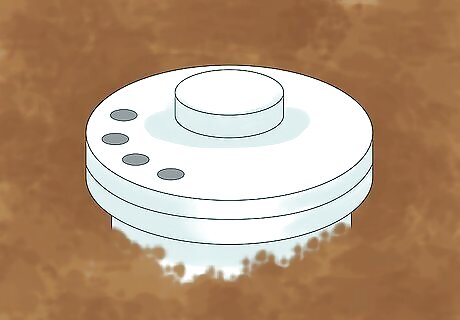
Identify how much connecting pipe is needed. Pipe is needed to connect the cylinder to a pump head and the plunger to a handle at the surface. The amount of pipe depends on the depth of the static water level in the well. From the top of the cylinder, you can reduce the pipe down to a 1-1/4in diameter pipe to save on cost and weight. However, it does increase the force required to pull the water to the surface (hydraulic principles). Before measuring the static water depth and well depth, first remove the well cap. This will reveal a secondary cap and the electrical connections. This cap is cemented to a pipe which connects to the pitless adapter (the device that holds the pump in place and connects the water from the pump to the line leading to the house below the frost level). You do not need to remove this cap or lift the pump at this time, as you only need to measure the static water depth. To measure the static water depth, tie a weight to some string or light rope. It is difficult to hear or see when the weight enters the water. Therefore, lower the weight down a few feet and bring it back up, feeling for water on the rope. Continue lowering the rope a couple feet further each time, until the rope comes up wet. Each time, mark the rope at the top of the well before pulling the rope out. Measure the distance from the weight to highest mark on the rope. This is the static water depth. Measuring the total depth of the well is more of a challenge because it is difficult to know when you hit bottom (or the top of the pump). Using fishing line may be helpful. Nevertheless, the static water depth is the important measurement. This indicates how much pipe (both the 1-1/4in outer pipe and the 1/2in inner pipe) is needed. To cover the 15 feet (4.6 m), and have the cylinder well below the static water level, use 20 feet (6.1 m) of pipe. The pipe will be connected with threaded couplers to aid in assembly and disassembly without cement. One additional detail to mention here is to drill a small hole in the side of the 1-1/4in pipe a few feet below the ground level. This will slowly drain water from the top of the pipe back into the well and thus prevent freeze damage.
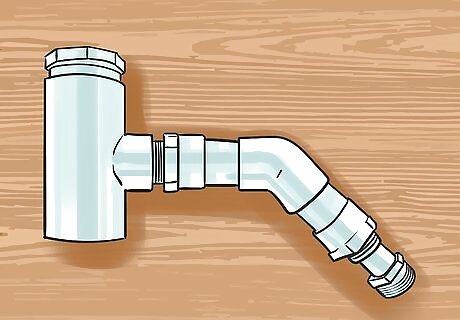
Build the pump head assembly. The pump head diverts the water coming up from the well out to a spigot. The 1/2in pipe from the plunger extends up to pump head and through the top where a handle is attached to operate the pump. a. 1-1/4x1/2in reducer. Ream out the bore with a 7/8in Forstner bit to allow the 1/2in pipe to slide freely. b. 1-1/4x3/4in threaded T coupler. c. 3/4in slip-male thread adapter d. 3/4in pipe e. 3/4in 45° elbow f. 3/4in pipe g. 3/4x1/2in slip-male thread reducer (optional) h. Brass female pipe, male hose adapter (optional) To prevent water seeping up through the 1-1/4x1/2in reducer (a) around the pipe handle a gasket (b) needs to be inserted. A washer (c) holds the gasket tight to the reducer and a 3/4x1/2in reducer (d) (cut short and reamed out) is cemented into the reducer (a) to hold the washer and gasket in place.

Build the handle and lever arm. At the top of the 1/2in pipe, a T handle can be added for direct manipulation of the pump. A lever handle can also be attached to the pump head assembly if needed for deeper wells. You might also add to your to-do list an alternative well cap that will accept the pump head assembly.
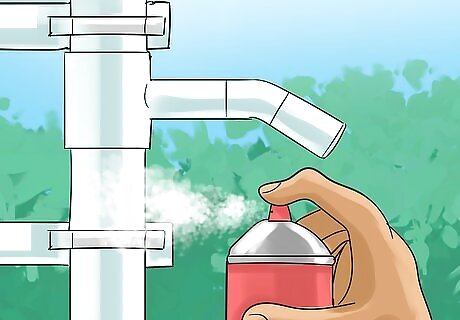
Protect the PVC pipe. UV rays from the sun will make PVC pipe brittle and can weaken cemented joints. Any exposed PVC pipe can be spray painted with an opaque paint to protect against this effect.
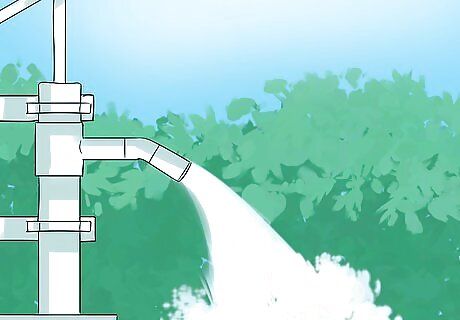
Understand how the pump works. When the pump handle is pulled up, water is drawn in to the lower cylinder through the foot valve. When the pump handle is pushed down the water is forced through the check valve above the plunger and into the upper cylinder. When the pump is pulled up again, water is pulled in through the foot valve, and also the water that was pushed into the upper cylinder in the previous cycle is pulled up to the surface.
Alternative pump operation
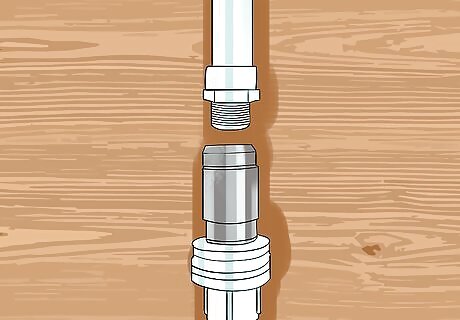
Make an alternative pump operation if needed. With the configuration described above, water is lifted to the surface when the handle is pulled up. If not using a lever handle, this may be awkward and/or difficult as you are relying entirely on your arm muscles to lift the water. The pump can be reconfigured to push the water on the down stroke, which would leverage your body weight. To accomplish this, simply connect the 1/2in pipe handle directly to the brass check valve above the plunger. In this configuration, the water will go up the handle and thus require a completely different pump head. (One option is to connect a hose to the T handle used to operate the pump.)
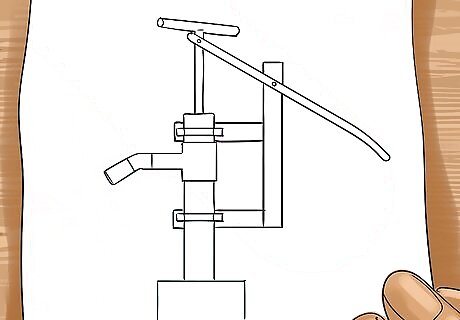
Be aware that you may prefer the original design for the following reasons: You may not want the water coming out of the handle. You might plan to use a lever handle (which pulls the water up when you push down on the handle). The force of pushing down on the 1/2in pipe to do the work may lead to buckling issues. The water in the pipe must still be pulled up to the surface with the alternative design. The alternative assumes the cylinder above the plunger is dry. There is a good chance the gasket will not form a perfect seal and leak water into the chamber anyway. It is not as easy to drain water from the internal pipe to prevent freeze damage.
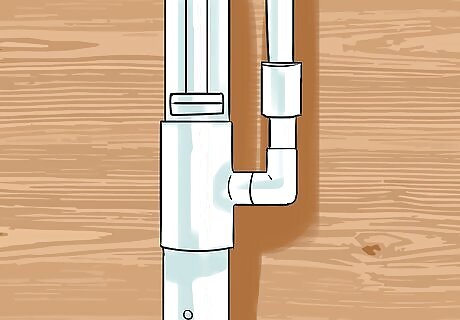
Make alternative pipe configuration. Another alternative design uses a rigid pusher rod rather than the 1/2in pipe (which could also be employed in the original design above) and a separate supply pipe to the surface. This design uses more materials, may not fit in most wells, and the pump head may be more complicated. This option operates just like the previous one. The only difference is the water pipe and pusher rod are separated.




















Comments
0 comment